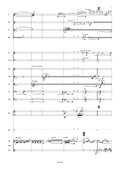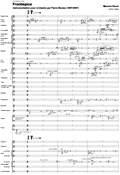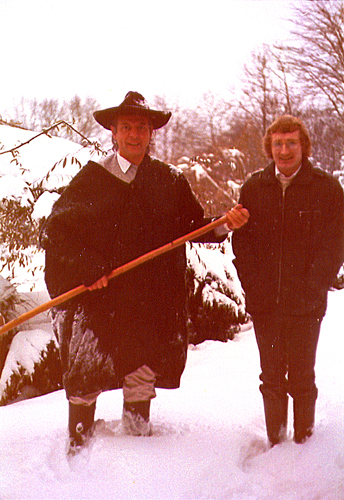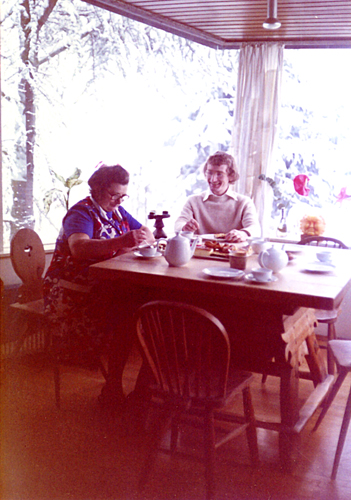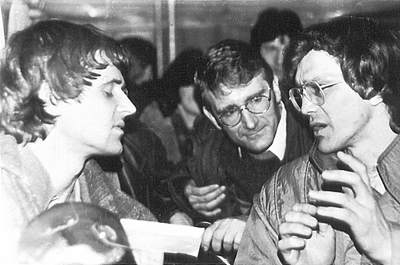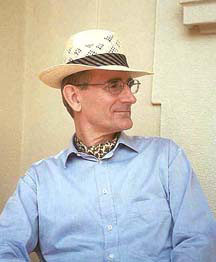An interview about my work as Stockhausen’s copyist (June 1974 to December 2000) with
Paul Roberts,
who was Luciano Berio’s assistant from October 1989 until Berio’s death in May
2003. Paul still produces new Berio scores (where necessary) for Universal Edition. He also
does scores by Birtwistle and Feldman etc., as I did in the early 1970s.
This is the April 2009 version of a text which
Gisela Gronemeyer
translated into German for
MusikTexte, Volume 117,
May 2008. Additional material includes several new photos and music examples.
I would especially like to thank
Universal Edition
for kindly letting us include some
examples from
my early work and Paul's recent scores.
Paul Roberts and I met at Berio’s Institute
Centro Tempo Reale in 2001, where
I was attending a seminar on digital music publishing. We have not met personally again, but
continue to keep in touch with a Christmas card every year. In 2007, just after Stockhausen’s
death in December, Paul also sent me an email, asking me about Stockhausen’s music since
Harlekin, and suggesting that it might be interesting to compare notes on our different
experiences.
I wanted to write something on the occasion of Stockhausen’s death anyway, so it seemed
like a good idea to ask Paul to act as my “interviewer”. That helped me to keep
the text objective, and to stick to musical and artistic themes, interesting to the outside
world. Many thanks Paul, for being a brick. Your contribution has been invaluable.
Many thanks also to Gisela Gronemeyer, for publishing the original version of this text in
MusikTexte, and for her patience and help while translating it.
Paul Roberts: Strange coincidence that we are both English...
James Ingram: The English make good butlers!
PR: You parted company with Stockhausen at the end of the year
2000. It can’t have been the best day of your life when you discovered that your services
were no longer required. What happened?
JI: That’s a rather complicated question, but one which
is well worth trying to answer. I am, myself caught up in this story, so its rather difficult
for me to get at the truth – if there is a single truth.
One has to look at the problem from both Stockhausen’s and my perspectives. If one looks
at it from his direction, the answer provides a clue to understanding
Licht as a whole.
In my world, the answer has to do with the end of the era in which artists are heroes.
There is no blame attached to any of this. Events unfolded inevitably, as in a Greek tragedy.
I think Stockhausen must have been identifying me with Lucifer at the time. In
Sonntag,
at the end of
Licht, Lucifer is left behind so that a pure Assumption can take place.
Remember that one of the main events associated with Lucifer is that he is thrown out of heaven
at some point. This happens in real life, not in any of the operas. For Stockhausen, getting
rid of me was a catharsis. (Remember
Spiral?
Inori?)
Also, on a mundane level in Stockhausen’s private life, he was worried about my self-employed
status. He was afraid that the authorities were going to force him to give me a proper contract,
which might have been very expensive. I had to go.
My being made redundant was for me (and probably for Stockhausen too) a real life hell. The
dragon fight continued in the real world, invisible to the observers of
Licht, from
2001-2003.
From my perspective, the dismissal has to do with the coming of the internet. Suddenly, in
February 1999 when I published the first version of my web site, I had become visible and
able to talk to the outside world. This meant that I could start discussing and developing
my ideas on music notation, which had been stagnating since the mid 1980s for lack of any
discussion. But my visibility was a problem for the hero Stockhausen. I started training my
successor within a couple of months of going online.
The problem was this: In 1983, after pushing the dots around for a decade or so, I had made
a real conceptual breakthrough. This demolishes some of the key ideas embodied in standard
notation - especially the
Avant-garde’s and Stockhausen’s view of standard
notation. These ideas were published in an essay
The Notation Of Time in 1985. The essay was rejected by the academic press
(as is usual in such cases) and published in a small, non-academic magazine for composers.
The article subsequently sank without trace, until I put it on my website.
After Stockhausen had read and understood it (1984), he told me he was going to ignore it
and continue writing as before. He also quietly gave up pretending that he was interested
in influencing the future of music in general. If you compare the program notes for
Michael’s
Reise (Donaueschingen 1978) with what he writes later, there is a point where his
attitude changes. He was simply too old, and too far into
Licht to be able to pull
up his roots and start again. I don't blame him at all. It was fate. We were locked into the
same story, whether we liked it or not.
It remained vital that I should not rock the boat, or disturb his public image. Nobody wanted
to listen to me anyway. I had no choice, but to continue as if nothing had happened. Nicola
Bernadini invited me to the seminar at
Centro Tempo Reale in 2001, as a direct result
of his discovering my website. This was exactly the kind of thing Stockhausen did not want
to happen.
PR: Let’s go back to the beginning. You once said that you
had done some work for UE London, including preparing some of the performance material of
Boulez’
éclat-multiples. How did you meet Stockhausen? These kind of jobs are
not exactly advertised in the papers...
JI: I studied composition with Birtwistle from 1967-71 at the
Royal Academy of Music in London. Heady days for music! At the time, Boulez was conducting
the BBC Symphony Orchestra, bringing a fresh wind to that world. Stockhausen was the other
Big Name in New Music.
As students we were all fascinated by the way music was developing. I remember performing
Oben und Unten with students from the other London colleges, and attending an electrifying
Stockhausen concert at the St Pancras Town Hall. He was there, with two ensembles:
Intermodulation
(around Roger Smalley) and
Gentle Fire (around Hugh Davies). Our ears were wide open.
What we didn't realize at the time, was that the whole scene was about to collapse. It actually
collapsed in 1970, but the news didn't reach me until later.
Through Birtwistle, I began working for UE London around 1968. At first it was just copying
parts, but they soon began giving me other work. The first printed score I did was Morton
Feldman’s
On Time and the Instrumental FactorUE1.
I subsequently made several other Feldman scores and got to know him personally - he was friends
with Birtwistle. Feldman was a great Artist, and for me continues to be a very important composer.
I also made scores by Earle Brown and Birtwistle, and was occasionally involved with other
composers too: Boulez, as you say, and Maxwell Davies.
My first connection with Stockhausen came when UE Vienna asked me to notaset the
D-Momente.
That’s how I first met Hugh Davies. A condition was that I had to agree the detailed
look of the score with Stockhausen himself. So we were corresponding in early 1974 while the
crisis about the
Inori orchestra material was brewing. In June, he wrote asking me
to go to Kürten to sort that crisis out. I arrived as a professional on 28th June 1974. We
were on equal terms. I was never his student.
PR: So it was your own background as a composer that encouraged
you to get involved? Composers are the best people for this kind of work.
JI: Yes. To be more precise, I got into copying because I’m
interested in written music and wanted to stay close the problems I thought needed solving.
Most people drift off into academic careers, but academics have to be too eclectic. They don't
get under the surface of the problem, or give sufficient weight to the fact that music notation
is simply blobs of ink on paper - a purely spatial phenomenon. Western music history is the
history of
written music until the invention of mechanical recordings at the beginning
of the 20th century.
Culture is, for me, ultimately inseparable from writing, in spite of the flowering of non-written
musics over the past 100 years. I think there
is a future for written music, but scores
now have to be thought of as software. Scores have always been scripts describing sequences
of events...
As a composer, I have always wanted to write music whose notation was free of contradictions
or superfluous concepts, so I started by using a very simple set of symbols, and tried to
think very carefully before using a new symbol or graphic construct. This means that I have
produced very few compositions. My work is more like a research project.
According to a New Music manager’s idea of what a composer is, I’m probably not
a composer at all. Composers are people whose prime directive is to create temporal objects.
What their notation looks like (if any) is irrelevant. So composers are not the best people
to be asking fundamental questions about music notation. No wonder everything collapsed.
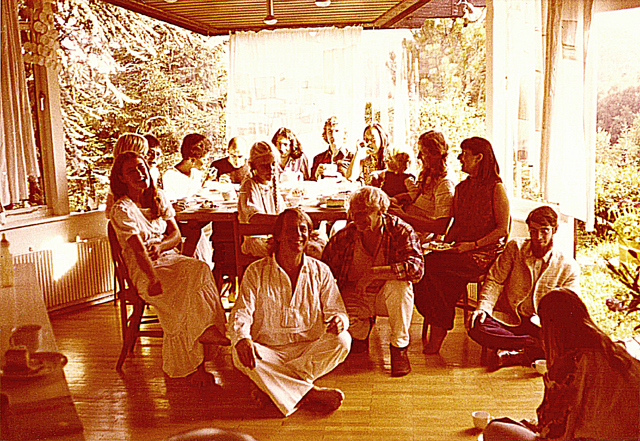 Summer 1974, Inori: clockwise round the table: Julika Stockhausen
(sitting behind Stockhausen), Suzee Stephens, Simon Stockhausen, Georg Wolff, Elisabeth Clarke,
Alain Louafi, János Darvas, James Ingram, Keiko Nishimoto, Sophie Bauermeister (daughter of
Mary Bauermeister), Mary Bauermeister, student of Bernhard Wosien, probably her friend, Bernhard
Wosien, Stockhausen. Stockhausen wanted an older man (Wosien) to learn Inori too, but nothing
came of it.
PR
Summer 1974, Inori: clockwise round the table: Julika Stockhausen
(sitting behind Stockhausen), Suzee Stephens, Simon Stockhausen, Georg Wolff, Elisabeth Clarke,
Alain Louafi, János Darvas, James Ingram, Keiko Nishimoto, Sophie Bauermeister (daughter of
Mary Bauermeister), Mary Bauermeister, student of Bernhard Wosien, probably her friend, Bernhard
Wosien, Stockhausen. Stockhausen wanted an older man (Wosien) to learn Inori too, but nothing
came of it.
PR: I rather like
Inori (or parts of it, especially the
Harmony section which I bet he wrote at the piano. I find the Polyphonic section awkward with
all the various lines playing simultaneously. To me they simply play together but without
any real musical grammar.) What do you think of it?
JI: I like neither the sound nor the aesthetics. The picture of
him conducting it in Rome 1975 (printed on the front cover of his Texte Band IV in 1978),
shows him trying to rejoin the dying, bourgeois music world we thought he was replacing in
the 50s and 60s (he’s pretending to be Karajan). That was, for me, the wrong way to
go.
I loathed the Urantia book, which was uppermost in his mind at the time. He was mentally in
a very precarious state, susceptible to frequent tantrums. At meals, he would deliver endless
monologues on Urantia chapters as if they were literally true. Intergalactic bureaucracy,
blue and green people fighting over Africa at the beginning of civilization. Lucifer’s
rebellion. Hierarchies of angels living on Sirius, etc.
On the afternoon I arrived, I was very seriously introduced to the assembled community as
“A messenger from the Local Universe”.
A wild book could be written about the creation of
Inori during the summer of 1974...
PR: From this period in the 1970’s Stockhausen certainly earned
his particular mystic reputation. Can you tell me something about your own beliefs? How did
you stay sane?
JI: I was certainly forced to take a stand of some sort.
There’s an entry in my diary for 20th August which says “I believe it is necessary to
believe only that which it is necessary to believe.” That’s Occam’s Razor. In the late
seventies, I got a bit further, and summarized my view in a little poem
that more is
but beyond words
is will be misunderstood
So there’s actually nothing more that I can say in that direction.
PR: There’s too much (and growing?) misunderstanding around. If
I really push you – after all, working for Stockhausen can’t have left you without some further
thoughts...
JI: For me, “God” is a symbol for something which
cannot be symbolized. In this I’m close to the ancient Jews who forbade giving God a
name, and the New Testament “The peace of God
which passeth all understanding”.
I’m also a child of the 20th century. There’s a famous quote by Wittgenstein “
Wovon
man nicht sprechen kann, darüber muss man schweigen.” (“
One must be silent
about that which cannot be said.”)
I also believe that Popper’s and Goedel’s results mean that brains have a “blind
spot”, and that this “blind spot” results from the brain’s use of
time and symbols to reduce complexity. Jacob Bronowski’s series of television lectures
The Ascent of Man impressed
me very much during the early 1970s.
On a separate level, I believe (like a true Christian) that all actions should be informed
by love.
Theology is just very boring, compared with feeling the frontiers of knowledge expanding.
This constant expansion is in itself proof of the incompleteness of our knowledge. So artistic
and other explorations are closely connected to my unquestioned beliefs.
After the Donaueschingen premiere of
Inori, Stockhausen and I agreed on the arrangement
which held for the following 26 years. I became part of his household, working in his house
for half of each year. This was an ideal arrangement for both of us, and perfect for creating
the scores he wanted. For the other half of the year, he was on tour and I was free to pursue
my own projects.
I was paid by the hour, so Stockhausen was free to change things as much as he liked. I enjoyed
the hard work, and miss his perfectionism very much. It was my job to do what he wanted as
best I could, not to agree or disagree with his decisions.
This was gentleman’s agreement. I never pressed him to give me a written contract. He
said a couple of times that it would be better for him if I also worked for other composers,
but I was not interested in doing that. For me, the whole point of our cooperation was that
I should have time to work on my own long term projects.
George Mowat-Brown: My pipe wasn’t really that bad was
it?
JI: Huh?
GM-B: You’re telling us all about Stockhausen’s private
life. What about yours?
{
|
|
JI: I’m gay, but in 1974 was still some way from fully coming
to terms with the fact. Actually, my homosexuality is quite relevant to this story: Becoming
part of Stockhausen’s household was easy for me. I was not planning to have a family
of my own and I didn't disturb the peace. Eunuchs are not rivals.
I’d always tried to avoid the problem by burying myself in my work. It was only after
the fruitless publication of The Notation of Time that I attacked the matter directly
for the first time. I “came out” in Kürten in April 1985. There was an odd atmosphere
in the house for a week or so, as if he was half expecting to be seduced. (Vanity, vanity!)
But when he was satisfied that nothing awkward was going to happen, a unique, poetic event
occurred, and we dropped the subject.
{
|
I think that the Eve, Michael, Lucifer trio has a lot to do with the Suzee, Karlheinz, James
triplet.
This may not have been conscious, of course. But I was certainly an unbeliever...
In 1976, I thought that New Music’s problems could be solved just by using intelligence,
but that progress currently had to be made underground. Renouncing a public composer’s
career obviously gave me an advantage when it came to making real, theoretical progress, so
his fear of being overtaken increased.
In contrast, I believe that
both intelligence and intuition are necessary for maintaining
a sense of wonder. Intuition finds the problems which intelligence has failed to solve. Intelligence
or intuition (including religious belief) are static on their own. For Stockhausen, there
was a conflict between the two. Intuition was what enabled him to create. Intelligence made
him vulnerable. Profoundly Catholic, his dream was to leave intelligence behind.
The roles in
Licht are not consistent portraits of particular people of course. They
are abstract principles. But he often found it easier to isolate particular aspects of those
principles by thinking of particular people.
In the first piece, Jahreslauf, he modeled both Lucifer and Michael on himself. He is trying
to get above the conflict between his own conservative and progressive personae.
In
Donnerstag, he obviously modeled Michael on himself throughout (he got a lot of
stick for that). In Act I (
Michaels Jugend), his father is Lucifer and his mother is
Eve, but by the end of the opera he is using himself to feel his way into both male roles
again. Michael and Lucifer were now two aspects of one person. But in that case, why weren't
there two Eves?
Kathinka arrived after
Donnerstag, and was immediately cast as Eve’s other half.
Suzee does not appear in
Samstag, Lucifer’s day, at all. That complicated things
rather for the Formula. It would have been very different if Kathinka had arrived earlier.
The conception of
Licht also has to do with Stockhausen’s dislike of being categorizable.
At the time, he had the reputation of being “the chameleon”.
I think he wanted to kill a lot of birds with one stone: It freed him from the expectation
everyone had, that each work he produced would be as different as possible from the previous
ones; his extreme productivity was leading to a feeling of arbitrariness, which I think he
wanted to stop; and he wanted to continue in the direction of rejoining the bourgeois, but
still viable, cultural scene. Grand Opera is the opposite of what he was doing in the fifties
and sixties, but there was no way back to that world (the notational experiments had collapsed).
PR: A well-produced score is an incredibly difficult undertaking
– a mixture of pure complex technical musical details (which must be correct) but that require
refined aesthetic attention when converting a manuscript into a printed score. A score very
often contains plenty of input and sheer musical know-how and research on the part of the
person who is employed to make it. Of course all this remains totally anonymous – naturally
to the advantage of the composer.
JI: Yes. That’s part of our aristocratic, Romantic heritage.
Heroes have to appear to be above reality, so the mundane details are carefully hidden. This
pattern has always been a commercial winner. Heroes are easier to sell. But that is changing.
Try being a hero at an online forum, and you will see what I mean. I agree with you entirely
about the difficulty of setting scores. I think apprentices in the 19th century had to go
through one of the longest training periods of any job at all. I started with pen and ink
in the late 60s, and it was a case of learning by doing. Publishers were in a pretty decadent
state even then. They must have given up training their own engravers long, long ago. How
did you start? Pen and ink? Finale?
PR: Pen and ink. I had always liked well produced scores, and
had the fortune of being introduced to this world by Vic Hoyland. He gave me my first pens
(and ink) and got me one or two projects for UE London of his music. In fact, whilst at Birmingham
University they bought the 1st version of SCORE and I started fiddling with it by myself (there
was no one to teach it of course). I was absolutely amazed to find that the possibility of
producing ‘real’ scores was seemingly so close. After about a year I had a call out to Florence,
but that’s my story, and we are here to talk about yours. I had to change to Finale.
JI: That was 1989, right?
PR: End of September, to be exact.
JI: I’m amazed that you seem to get by using Finale on its
own. When the Stockhausen-Verlag started using computers in 1993, Finale was very buggy, and
awfully difficult to use.
PR: Finale in the beginnings was terribly hard to learn and use
well, at least for me. It was impossible to get a professional result, and it was necessary
to spend hours and hours getting simple things right.
|
The initial Berio scores I worked on were not very complex from the notation point of view
(Rendering, Ricorrenze, 8 Romanze). It took weeks to do what now is possible
in a single day. By spending so much time at the computer I gradually found the best ways
of cheating the program (there’s not a single default setting that is usable). The most
taxing scores I have produced from a notational point of view are Sequenza VII for oboe
and Circles. As long as I stick to scores with normal staves I should be o.k. Proportional
notation is not easy, but there’s always a way of doing it.
|
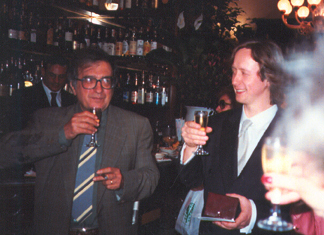
Luciano Berio and Paul Roberts (1992)
|
The problems start when a score has a lot of graphics. I’m not a computer programmer so I
can’t go any further. Presumably it goes without saying that Stockhausen’s most advanced notation
requires things beyond the boundaries of Finale and other notation programs?
JI: I never really tried to see what could be done by pushing
Finale to its limits, so I cant really answer that. Stockhausen always required unlimited
control over his scores, and I had to find a way to solve the problem quickly once we started
using computers. He wanted to keep both the freedom he had when I was using ink on paper,
and the ‘house style’ which we had evolved over the previous 19 years.
For me, that meant treating music notation as pure graphics. FreeHand and Illustrator were
the standard programs for doing graphics in the advertising industry, and large amounts of
time and money had already been spent making them into good, stable programs. The Finale user-base
and budget was tiny in comparison, so the program was correspondingly unripe.
Stockhausen didn't like digital technologies. He resisted their introduction, both at
the WDR Electronic Music Studio and at his own Verlag, as long as possible. At the time, it
felt as if he was simply being a drag, but I now understand him better. Its not the technology
which produces quality, but the expertise of the person using the technology. He was an expert
with analog technology who had to bow to change as it came. There are still people who prefer
high-end analog recordings.
Now, whenever a new version of a piece of software comes out, we have to ask ourselves if
it is worth re-training to use it or not. Increasingly, for standard software, the answer
is no. That’s one of the software industry’s current problems.
PR: I recently had to upgrade Finale from version 2003 to 2008.
I had to buy a new computer in order to run it (my 3rd since working with Finale). I am finding
the latest version rather disappointing. With 1 gigabyte of RAM it is slower than version
2003, and there is scarcely a single improvement to notational aspects for my needs. In addition,
I have to relearn a great deal of the program because they have changed so many of the keyboard
shortcut commands and shifted many of the most useful tools I was used to under different
menus without actually improving much the capabilities of the notational tools.
I can’t understand why. For me there are no advantages to this new ‘layout’. It’s frustrating
having to hunt for things which used to have their own pull-down menu. By the way, you still
can’t even rotate text (unless by cheating the program) which was something you could do
in version 1 of SCORE over 20 years ago. (Text rotation is necessary for music printing of
all ages, particularly in marginalia of Opera and vocal scores.) Apparently it can play back
scores better than it could before, but since it still isn’t even capable of producing an
only mildly complex score without the user having to invent ways of making the notation look
right, I know that this aspect isn't suitable for composers yet.
JI: Back in 1993 at the Stockhausen-Verlag, the forewords to the
scores were being created by pasting my pen and ink diagrams into text which was set using
an IBM Selectric golf-ball typewriter. I was using a Graphos pen (standard for copyists since
long before I started), and/or Letraset and Notaset. All these technologies became obsolete
as the printing industry switched to computers. Stockhausen scoured Germany for the last golf
balls, Graphos nibs and Notaset, but eventually they ran out, and we were forced to join the
general trend.
I’d been teaching myself to program since 1981, so I soon decided to do as little as
possible with Finale, and export the files to FreeHand via software which I would write myself.
(Remember I had ca. six months a year free, and I wasn't making progress with my abstract ideas
on music notation. I needed a challenge.) My first solution was to read Finale’s postscript
output, change it, and simply send the result to FreeHand. But that solution didn't last long,
because Finale’s postscript output changed with the next (slightly less buggy) release.
Learning from this mistake, I redesigned my software as a set of
FreeHand plugins as soon as that became possible in 1995. I also made a button for
converting simple, curved lines into slurs so that I didn't have to draw them at all in Finale.
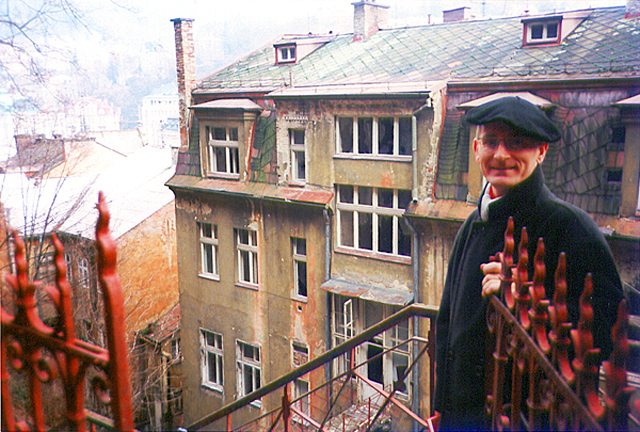 Karlovy Vary (Karlsbad), Czech Republic 1994
Karlovy Vary (Karlsbad), Czech Republic 1994
PR: That leaves me completely speechless. If I had had to be a
computer programmer just to get on with Berio’s scores, I would have not lasted more than
a week. The most impressive thing I ever did on my own was to create straight flags for the
publication of the Sequenza for Flute in 1990. But that’s child’s play compared with what
you were up to!
JI: As I said, Stockhausen wanted to keep our ‘house style’,
so we also created a new Finale-compatible font to match my handwriting. It has the straight
flags and various other special symbols he wanted. Stockhausen was, of course, the final arbiter
of how the symbols look, but I was responsible for presenting him with something he could
accept, reject or change. For example, I decided to make the free corners of each flag a little
more pointy by curving the external vertical slightly inwards, and decided on the exact shape
of the serifs on the dynamics. Those are the little details that make all the difference when
creating something which has character and is easy to read. Compare, for example,
XI: System 3 of Model C (handwriting) with
XI (Model A)
(FreeHand).
PR: How come you started programming in 1981?
JI: After the performance of my
Vectors at Donaueschingen 1978, Nicholas Snowman gave me a commission to write
a piece for the Ensemble Intercontemporain. I’m interested in algorithmic composition, and
was working on
beyond
the symbolic when personal computers first came on the market. I could see that
this was exactly what I needed to implement and develop the algorithms I was using, so I asked
Stockhausen to lend me the money to buy an Apple II.
The piece was performed in Paris in 1982. Boulez, Stockhausen and Birtwistle were in the audience.
The conductor was Sylvain Cambreling.
The piece is a single, large, complex data structure - like a protein. But as a result of
the notation, the players are forced into a temporal interpretation of the symbols not unlike
the performance practice of late Romantic music. It would go nicely in a concert with
Verklärte
Nacht. The audience booed, Birtwistle said it sounded “
very un-French”,
Stockhausen was polite - “
...like walking through a forest.”, Boulez said
nothing. We had had a week of rehearsals, but the performance was the first complete run-through.
I think Sylvain Cambreling only began to understand what it was all about half way through.
His parting words to me in the foyer afterwards were “
I'm so sorry.”
But the piece led directly to
The Notation of Time.
PR: And so what happened to you after 2000?
JI: I wrote to all the major publishers, looking for work. Peters
Edition in Frankfurt eventually gave me Silvestrov's
Eschatophonie Symphony and
’Cello
Sonata, but then dried up again. Major composers already have their personal copyists,
and publishers of other written music now expect composers to be amateur engravers who deliver
their own scores and parts - usually in Finale or Sibelius format. This does not help generate
the kind of conceptual expansion in the composers' minds, which for me is the reason for doing
Art. Composers whose mind-set is determined by the 19th century conventionalities of standard
software are not likely to produce anything very startling.
One nice project I landed was an invitation from
Curtis Roads to read an
updated version of The Notation of Time to a small group of people at his
Create Institute at the University
of Santa Barbara in California. He subsequently commissioned me to make a symbolic
transcription of his Sonal Atoms (electronic music), leaving me free to use
any notation I liked. We corresponded while I was doing it, and the result was conceptually
the most advanced score I had ever written - including any of my or Stockhausen’s music.
Through connections made at the
Centro Tempo Reale seminar, I eventually met
Hartmut Ring, who is the programmer of the
capella music notation editor. Hartmut
gave me a consultancy agreement and, together with Hans-Ulrich Werner of
capella-software, a new Windows laptop. I signed a non-disclosure agreement
with them, which is one of the reasons my website went off line in 2005. That consultancy
has now ended (very amicably). I learned a lot from Hartmut, and thank him very much for the
time we were working together. I am still watching
capella closely, and keeping my
software compatible with theirs.
PR: May I ask you more about your own current work?
JI: I’m programming (C# and .NET), using the free edition
of Microsoft’s Visual Studio programming environment. About a year ago, I started work
on
Moritz, which is a patch editor with which I want
to connect all the threads of my previous work (including algorithmic composition). Among
other things, Moritz can currently be configured to be a MIDI device which simultaneously
listens to MIDI input and follows a score, outputting MIDI instructions.
PR: I don’t quite understand, but this sounds as if it might be
very useful for other composers.
JI: I certainly hope it will, but I’m very isolated at the
moment, so who knows if Moritz, or the concepts involved, will ever be used by anyone else.
I’m hoping to put my website back up, and rejoin the community, once I’ve tested
everything enough. I want to produce some good demonstration files - and a new composition.
The “Who needs it?” problem is something we all have to face.
PR: Could you explain what Moritz does?
JI: I’m currently working on “power-performance”.
As the score is performed, by a real performer, events are triggered when the score calls
for them. To give a simple example: the software can replace the man who pulls the stops for
an organist. When the performer gets to a particular point in the score, the registration
can be changed automatically because the software knows where the performer is in the score,
and can interpret any information which occurs at that point. I’ve nearly finished implementing
the whole MIDI specification as a simple language which can be written (as text attachments
to chords) into any score. Other kinds of event, such as accompaniments or ornaments are also
possible.
In principle, any kind of pre-composed event can simply be written into a score so that it
happens at a time which is relative to the time of the other symbols (a time determined by
the performer). Performers are freed of mechanical time. Detailed timing (phrasing etc.) becomes
a matter of learned performance practice and interpretation. I think musical comprehension
requires a comparison of a particular interpretation with previously known interpretations.
Symbolic music notation is a far more powerful tool than space-time notation (as still used
in sequencers and other post-recording software like ProTools), since it can be used in real-time
applications, to develop grammars and to compose large forms. (The development of western
harmony and counterpoint would have been impossible without the use of writing.) A score is
a purely spatial object which can be read. Time is something a performer does. The complex
connection between the image of the graphics in the performer’s mind and what the performer
does, is in the performers head not on the page. For me, time and the use of symbols are just
brain strategies for reducing complexity. But I’m beginning to repeat myself. What are
you doing now?
PR: I’m still working on some Berio scores which have yet
to be engraved. I have also been doing some Boulez, Birtwistle
UE2 and Feldman. Isn't it odd, that you should have started
off with Birtwistle and Feldman before moving on to Stockhausen, while I started with Berio
and moved on to them!
During January (2008), Boulez is conducting a group of 4 short orchestral pieces which I engraved
ca. 2 years ago (called Entrata, Fanfara, Festum and Encore) which Berio had written over
the years. They never get played because they are for big orchestras and only last ca. 3 minutes
each. In a way they are a little like Boulez’s Notations. Normally they are impossible to
program for an orchestra. I had the idea to perform them as a sort of cycle (there are many
reasons which link them together) and I even suggested to UE to pass on the idea to Boulez.
After a long wait Boulez replied with great enthusiasm and has even given the group a title
– Quatre dédicaces. He is presenting them in Chicago and a couple of days later in Carnegie
Hall. (Of course I don’t get any credit for this.)
JI: Of course not! You are supposed to be invisible too!
PR: May I pick your brains? Could you recommend a selection of
Stockhausen’s later pieces (after Harlekin) which you consider as good as – if not better
than – his earlier music. I know the Helicopter Quartet which I think is a very interesting
piece (all the intense tremolandi remind me of Berio).
JI: Generally, I prefer the pieces written before I joined him,
but that may be because I’m getting older too. Here’s a selection of pieces I
like, written after 1969. The list is a bit arbitrary, but the following are well worth knowing.
Mantra (1970): I agree with Robin Maconie, that this piece is a masterpiece.
Its a turning point which, for me at least, marks the end of the
Avant-Garde period.
With this piece, he (like many other composers in 1970), relapsed into 19th century notation.
They had no choice, except to give up their careers. Contrary to contemporary
Avant-Garde
wisdom, it is not possible to create new sounding music just by changing the shapes of the
symbols, and the use of unconventional notations means that one needs impractical amounts
of rehearsal time. Stockhausen underlines the bourgeois aspects of this piece by insisting
that the performers wear tails. The contrast with hippies sitting cross-legged on cushions,
listening to
Aus den Sieben Tagen at the 1970 Osaka World Fair could not be greater.
Incidentally, the last job Stockhausen ever gave me was to make a few minor corrections to
the pencil originals. The corrections were so trivial, that I'm sure this was an allusion
to our long-term, underlying dispute over music notation. He could just as well have done
the corrections himself.
Trans (1971): Liked the dream and the veiled sound. I notasetted the score 1975-6.
Unfortunately, I have never experienced a live performance.
Unsichtbare Chöre (1979): Multitracked choirs. This was created in 1979 as a
background tape for Acts I and III of
Donnerstag aus Licht, but is available separately
on CD. The printed score, like the whole of
Donnerstag, is in my handwriting (pen and
ink). The production of the original choir material was one of the rare panics we had after
Inori. Acccording to my records, I worked 11 hours a day (that’s not including
time taken eating) for 31 consecutive days. The WDR Choir had been booked, and they ended
up snatching the material off my desk as fast as I could write, rehearsing and recording what
I had written the previous day. Stockhausen dedicated the piece to me just before it went
to the printers in 1986. (A couple of years after
The Notation of Time.) They played
it at his funeral. One of the interesting things about the
Unsichtbare Chöre is its
tuning. The tracks were recorded separately, and later mixed together, so the choir cant always
hear itself. As a result, the tuning is sometimes a bit “wrong”. Choirs of angels
as in a medieval painting. I like it best when played at a low dynamic. Its better if the
angels stay out of sight...
Vision (1980): The final scene from
Donnerstag. Classic
Licht.
Combination of ritual music and gesture. Unfortunately one cant see
Vision while listening
to the CD.
Montags-Gruss (1986/1988): A multitrack re-mix of
Xi for basset-horn. The basset-horn is played back at different speeds and
pitches. Underwater music, played in the foyer before a performance of
Montag aus Licht.
I found the opera itself dreadfully boring, but the
Gruss was nice.
Xi is an
interesting piece in itself, from a notation point of view. Extreme tuplets and microtones
etc. Shows how he thought about time and standard notation.
Xi was one of my last pen-and-ink
scores before the Stockhausen-Verlag got computerized.
Freitag aus Licht (1991-94): My favorite of the operas. Possibly because it
is partly about the marriage of people and machines. Its his reaction to the advent of computers
(which intelligence uses to seduce us). Possibly also because of its ambiguities and its being
sometimes so politically incorrect that one has to laugh (the alternative is too dreadful
to contemplate). Also because of Johannes Conen's fantasic stage realization, and because
Freitag-Versuchung is technically
the most advanced score I produced for Stockhausen (full use of all my experience and
software). Michael Manion did the basic work of creating the initial
Finale files, but it was a long way from
there to the final score! The score also contains a full photographic record of the production,
and is heartily to be recommended. (Buy it! Buy it!
Here!)
The piece is a good example of the danger into which his absolute trust in his intuition could
lead him. The piece ends with a beautiful “auto-da-fé”, with mixed-race beings
(“bastards”) being ceremoniously burned. Kathinka calls “Do you all repent?”,
but we are not told why they should repent. Nobody notices what’s happening (if Stockhausen
notices, he does not care) because he does his best, as always, to make things as beautiful
as possible.
Lichter-Wasser (1998-99): Great piece, great performance at Donaueschingen 1999.
Most of the time, the players are standing at isolated points in among the audience. They
play single pitches from melodies which thus move around in space. Real
Klangfarben-
and
Raum-Melodien. There are many passages which have the delicacy of the 1950s avant-garde.
In practice, this piece can only really be understood in a real performance in real space.
As with
Vision, the CD cant do it full justice. The instrumental parts posed an interesting
problem. In order to link the melodies, the performers not only had to know where in the melody
their note came, but they also had to match the linked notes’ dynamics more exactly
than can be easily notated... After solving the problem with the parts, the performed dynamics
were solved during extensive rehearsals.
Studie II (1954): Great piece. I made a new edition of the score in 2000 (using
FreeHand) because the original plates had deteriorated so much by being repeatedly re-photographed
since the mid 1950s. There were a couple of mistakes in the original score, which we corrected.
Stockhausen preferred his original version of the tape (in which the faders were adjusted by
hand) to the computer-generated versions which he heard later. Remember the shock when we
first heard Bach played literally? This is an important piece in the history of space-time
notation. Funny that I had to distort the time axis – to make space for the numbers...
 Summer 1974, Inori: clockwise round the table: Julika Stockhausen
(sitting behind Stockhausen), Suzee Stephens, Simon Stockhausen, Georg Wolff, Elisabeth Clarke,
Alain Louafi, János Darvas, James Ingram, Keiko Nishimoto, Sophie Bauermeister (daughter of
Mary Bauermeister), Mary Bauermeister, student of Bernhard Wosien, probably her friend, Bernhard
Wosien, Stockhausen. Stockhausen wanted an older man (Wosien) to learn Inori too, but nothing
came of it.
Summer 1974, Inori: clockwise round the table: Julika Stockhausen
(sitting behind Stockhausen), Suzee Stephens, Simon Stockhausen, Georg Wolff, Elisabeth Clarke,
Alain Louafi, János Darvas, James Ingram, Keiko Nishimoto, Sophie Bauermeister (daughter of
Mary Bauermeister), Mary Bauermeister, student of Bernhard Wosien, probably her friend, Bernhard
Wosien, Stockhausen. Stockhausen wanted an older man (Wosien) to learn Inori too, but nothing
came of it.
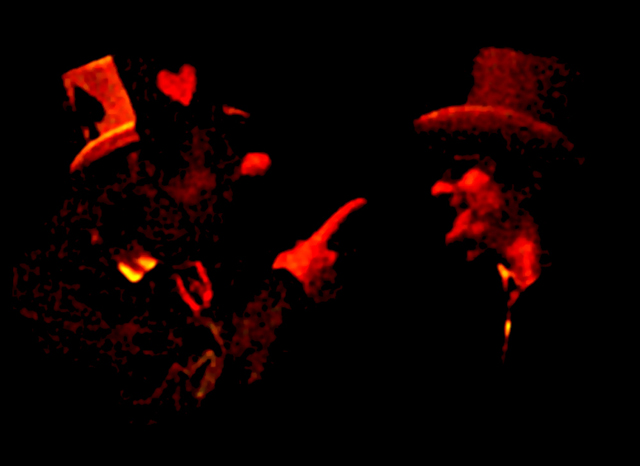
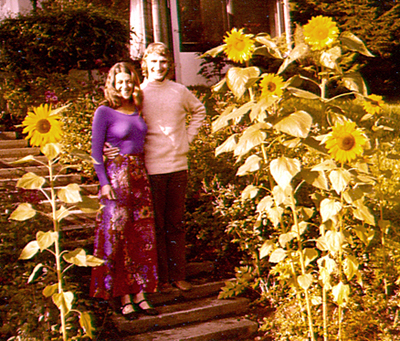 Kürten 1974, with Suzee Stephens
Kürten 1974, with Suzee Stephens




